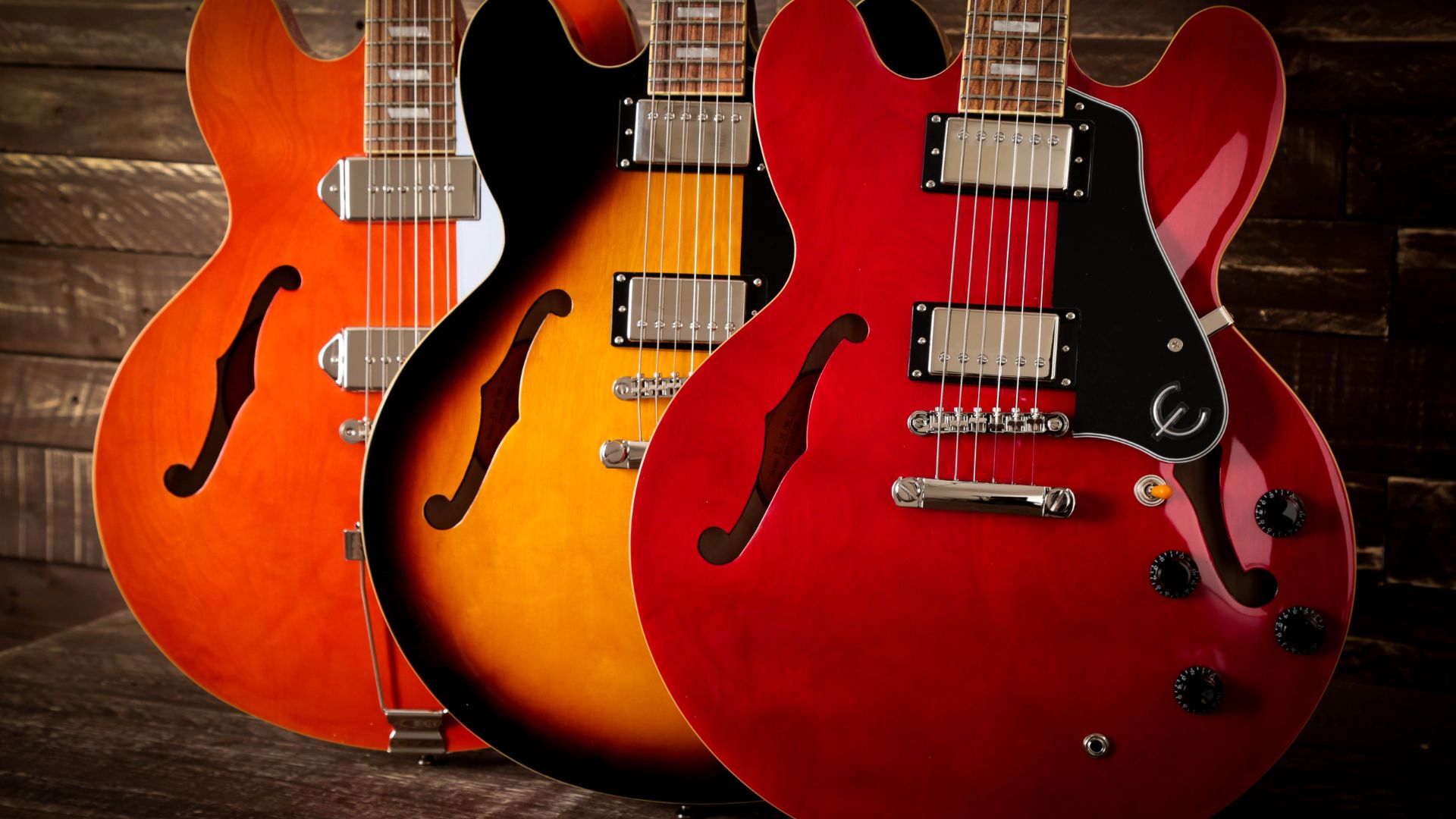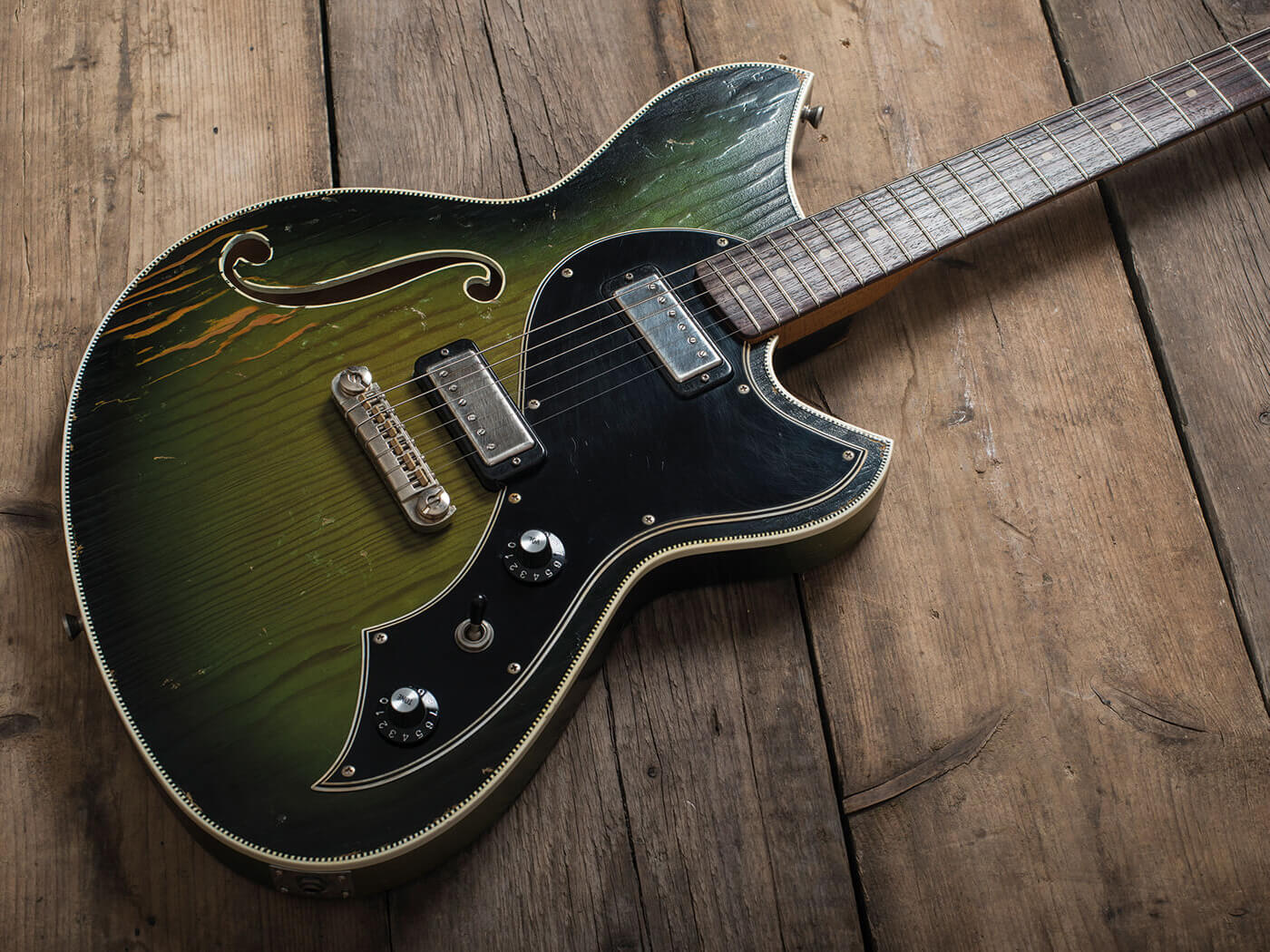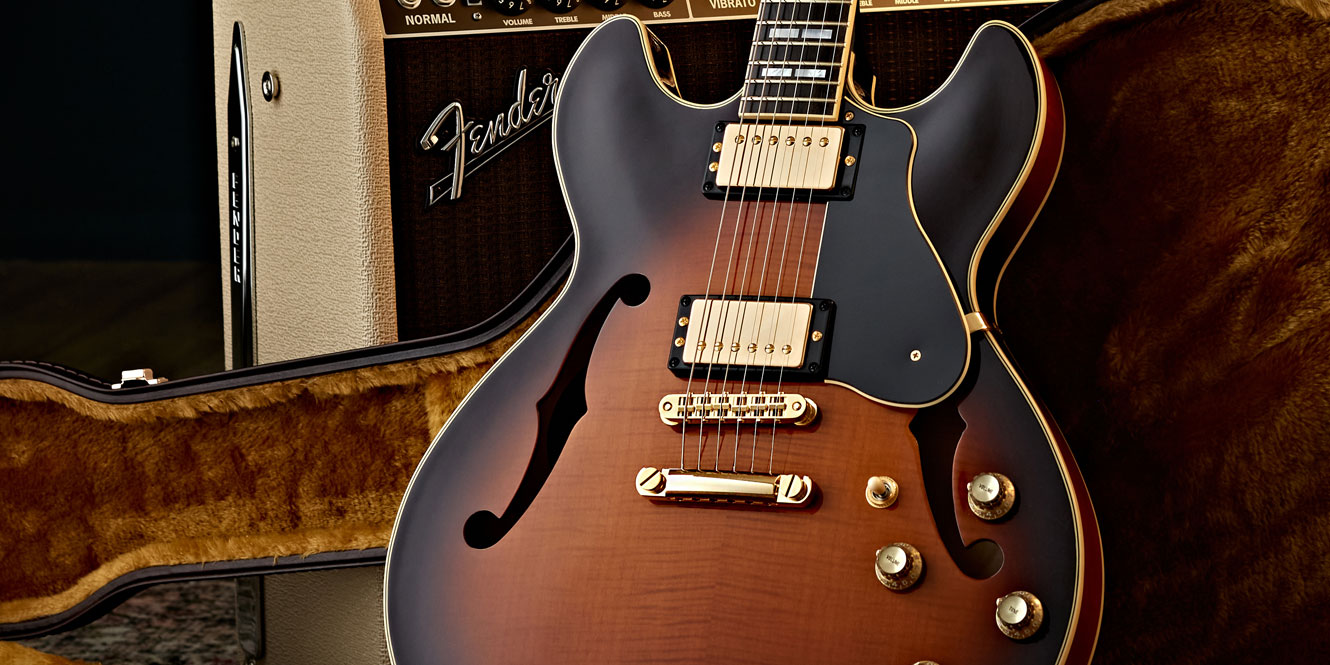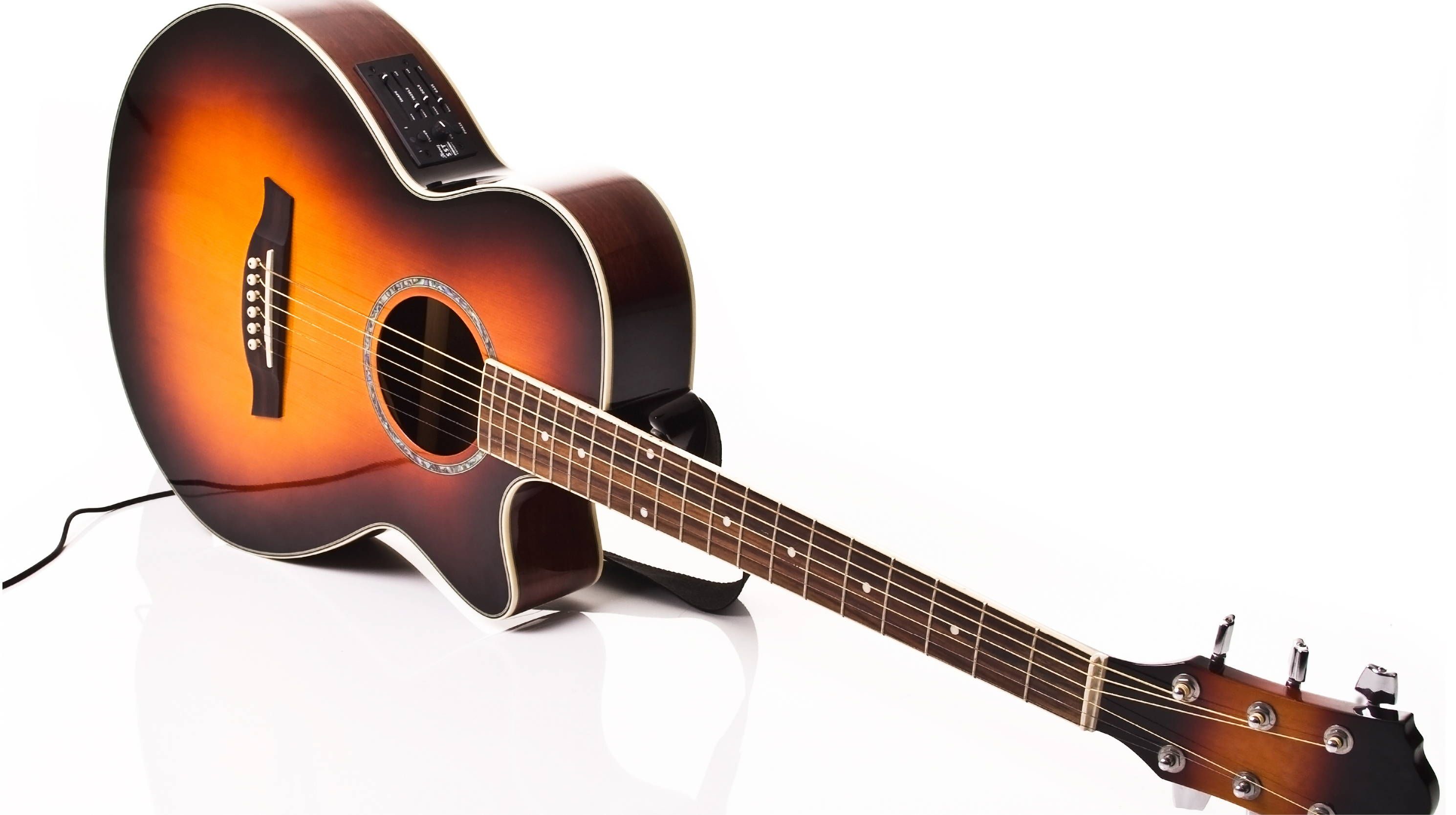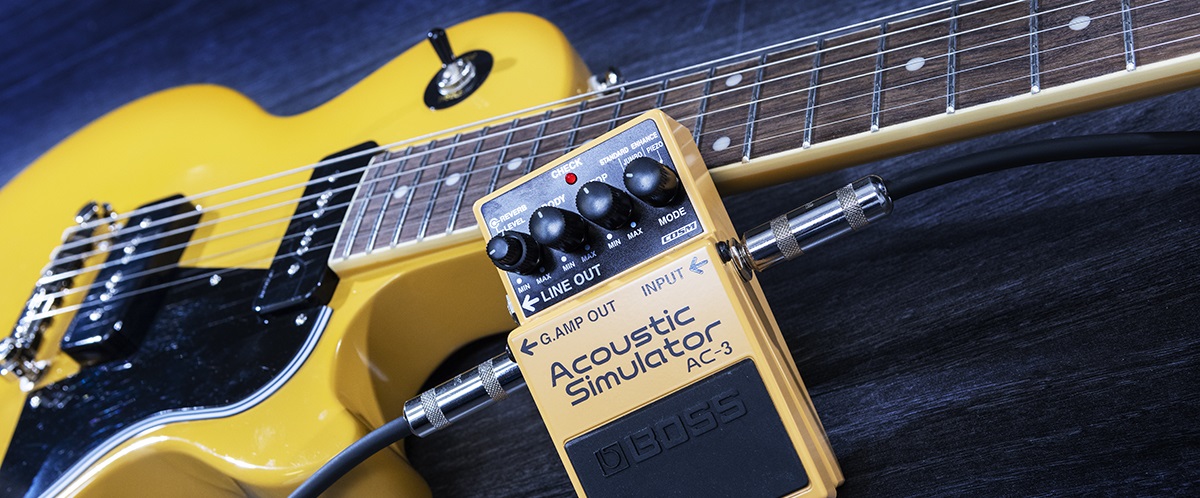Introduction
Welcome to the world of music and the mesmerizing sound of the semi-acoustic guitar. If you’re passionate about playing the guitar and want to explore a new dimension of sound, then the semi-acoustic guitar is a must-try for you. With its unique design and versatility, this instrument offers a balance between the warmth of an acoustic guitar and the power of an electric guitar.
The semi-acoustic guitar, also known as a hollow-body or thinline guitar, combines the acoustic resonance of a hollow body with the possibility of amplification, thanks to its built-in pickups. This allows the player to enjoy the rich, natural tones of an acoustic guitar, while also having the option to plug into an amplifier or sound system for a louder and more versatile performance.
Unlike a solid-body electric guitar, which is entirely made of solid wood or other materials, a semi-acoustic guitar features a hollow body. This hollow chamber enhances the guitar’s resonance, resulting in a warmer and more resonant sound. The sound produced by a semi-acoustic guitar is often described as smooth, balanced, and full-bodied – making it suitable for a wide range of musical genres.
One of the defining characteristics of a semi-acoustic guitar is its f-holes. These are two “f”-shaped openings on the guitar’s top, which not only add to its aesthetic appeal but also contribute to the guitar’s acoustic properties. The f-holes serve the purpose of projecting sound waves from the hollow body, allowing the guitar to produce a louder and more well-defined tone.
In recent years, the popularity of semi-acoustic guitars has soared, with many renowned musicians incorporating them into their performances. Artists like B.B. King, Eric Clapton, and Dave Grohl have all embraced the unique sound and versatility of the semi-acoustic guitar, making it an iconic instrument in various musical genres, including blues, rock, jazz, and even pop.
Now that you have a brief introduction to the semi-acoustic guitar, let’s dive deeper into its characteristics, advantages, and disadvantages. Whether you’re a beginner looking to invest in your first guitar or an experienced player wanting to expand your instrument collection, the semi-acoustic guitar is definitely worth considering.
Definition of a Semi-Acoustic Guitar
A semi-acoustic guitar, also known as a hollow-body or thinline guitar, is a stringed musical instrument that combines the acoustic properties of an acoustic guitar with the ability to be amplified like an electric guitar. It is a versatile instrument that offers the best of both worlds, allowing players to enjoy the natural, warm tones of an acoustic guitar while also having the option to amplify their sound for larger venues or performances.
The defining feature of a semi-acoustic guitar is its hollow body, which creates an acoustic chamber that enhances the guitar’s resonance and produces a distinctive sound. This hollow body is usually made of wood, such as maple, mahogany, or spruce, and is designed to provide optimal acoustic projection. The body of a semi-acoustic guitar is typically thinner compared to a traditional acoustic guitar, making it more lightweight and comfortable to play.
Unlike an electric guitar, which relies solely on electronic pickups to produce sound, a semi-acoustic guitar features both magnetic pickups and a resonant hollow body. The pickups, usually located near the neck and bridge of the guitar, capture the vibrations of the strings and convert them into electrical signals that can be amplified through an amplifier or sound system.
Another distinguishing feature of a semi-acoustic guitar is its f-holes. These f-shaped openings on the top of the guitar not only add to its aesthetic appeal but also contribute to its acoustic properties. The f-holes allow the sound to resonate and project from the hollow body, giving the guitar its characteristic tone and volume.
Semi-acoustic guitars often have a wide range of controls, including volume and tone knobs, pickup selector switches, and sometimes even built-in equalizers. These controls allow players to shape their sound and find the perfect balance between the guitar’s acoustic qualities and the amplified signal.
The versatility of the semi-acoustic guitar makes it suitable for a variety of musical genres, including jazz, blues, rock, and country. Whether you’re performing in an intimate acoustic setting or cranking up the volume in a band setting, the semi-acoustic guitar offers the flexibility to adapt to different playing styles and musical contexts.
In the next section, we will explore the characteristics and features of a semi-acoustic guitar in more detail, highlighting its unique attributes that set it apart from other types of guitars.
Characteristics and Features of a Semi-Acoustic Guitar
Semi-acoustic guitars possess several distinctive characteristics and features that make them stand out from other types of guitars. These features contribute to their unique sound and playability, making them a popular choice among musicians of various genres. Let’s explore some of the key characteristics and features of a semi-acoustic guitar:
1. Hollow Body: The hollow body of a semi-acoustic guitar is its defining feature. This hollow chamber enhances the guitar’s resonance, allowing for a warmer and more resonant sound compared to solid-body electric guitars. The size and shape of the hollow body can vary, impacting the overall tonal qualities of the instrument.
2. F-Holes: The f-holes, located on the top of the guitar’s body, are not only visually appealing but also serve an important acoustic function. These f-shaped openings allow sound to project from the hollow body, resulting in improved volume and projection. The shape, size, and placement of the f-holes can impact the tonal characteristics of the guitar.
3. Acoustic Resonance: Due to the hollow body and f-holes, semi-acoustic guitars possess natural acoustic resonance. This allows the instrument to produce a rich, warm, and balanced tone, similar to that of an acoustic guitar. The acoustic resonance gives the guitar a natural depth and adds to its overall character.
4. Electromagnetic Pickups: Unlike a traditional acoustic guitar, a semi-acoustic guitar features electromagnetic pickups that convert string vibrations into electrical signals. These pickups are usually placed near the neck and bridge of the guitar and capture the nuances of the strings, making the guitar capable of producing a wide range of tones.
5. Control Knobs: Most semi-acoustic guitars come equipped with control knobs, allowing players to adjust the volume and tone of the instrument. These knobs enable the player to shape the sound and find the desired balance between the natural acoustic tones and the amplified signal.
6. Versatility: One of the major advantages of a semi-acoustic guitar is its versatility. It can be played acoustically, delivering warm and resonant tones for intimate settings, or amplified through an amplifier or sound system for larger venues. This versatility makes the semi-acoustic guitar suitable for a wide range of musical genres, including jazz, blues, rock, and more.
7. Playability: Semi-acoustic guitars are designed with playability in mind. With their thinner bodies, they tend to be lighter and more comfortable to hold and play for extended periods. The neck profile and fretboard also contribute to the overall playability, allowing players to navigate the guitar easily and comfortably.
These characteristics and features make the semi-acoustic guitar a highly versatile and appealing instrument for musicians across different genres and playing styles. In the next section, we will explore the differences between a semi-acoustic guitar, an acoustic guitar, and an electric guitar to provide a better understanding of how they each uniquely contribute to the world of music.
How a Semi-Acoustic Guitar Differs from an Acoustic Guitar and an Electric Guitar
While the semi-acoustic guitar shares similarities with both the acoustic guitar and the electric guitar, it possesses distinct characteristics that set it apart. Understanding the differences between these three types of guitars can help players make an informed choice based on their playing style and musical preferences. Let’s explore how a semi-acoustic guitar differs from an acoustic guitar and an electric guitar:
1. Sound Production: The main difference lies in how each guitar produces sound. An acoustic guitar relies solely on the vibration of the strings, which resonates through the body and produces sound without the need for additional amplification. A semi-acoustic guitar, on the other hand, combines the acoustic resonance of a hollow body with electromagnetic pickups to capture and amplify the sound. An electric guitar relies entirely on the pickups and requires an amplifier to produce sound.
2. Amplification Capabilities: An electric guitar is designed specifically for amplified performance, as it requires an external amplifier to produce sound at usable volumes. The semi-acoustic guitar offers the option to play acoustically or plug into an amplifier for greater sound projection and versatility. An acoustic guitar is primarily played acoustically, without the need for amplification.
3. Tone and Sound Characteristics: The tone and sound produced by each guitar also differ. An acoustic guitar has a rich and natural sound, with a warm and resonant tone. A semi-acoustic guitar combines the warm tones of an acoustic guitar with the ability to achieve a wider range of sounds due to its electromagnetic pickups. An electric guitar has a more versatile and manipulatable tone, allowing for a wide range of effects and sonic possibilities.
4. Playing Style: The playing style for each guitar can vary. An acoustic guitar is often played with fingerpicking or strumming techniques, allowing the natural sound to shine. A semi-acoustic guitar can be played using similar techniques, but with the option to explore different effects and playing styles through amplification. An electric guitar is typically played with a pick and lends itself well to techniques such as bending, sliding, and tapping.
5. Construction: The construction of each guitar also differs. An acoustic guitar has a hollow body, usually made of wood, which contributes to its resonance and sound projection. A semi-acoustic guitar also has a hollow body but includes electromagnetic pickups for amplification. An electric guitar has a solid body and relies entirely on pickups and electronics for sound production.
6. Musical Genres: While all three guitars can be used in various genres, certain genres are commonly associated with each. Acoustic guitars are often favored in folk, country, and singer-songwriter genres. Semi-acoustic guitars have found their place in jazz, blues, and rock genres, offering versatility and a balance between acoustic and electric capabilities. Electric guitars dominate in genres like rock, metal, and pop, due to their ability to achieve high gain and manipulate the sound with effects.
Understanding these differences can help guitarists choose the right instrument for their preferences and playing style. In the next section, we will discuss the advantages and disadvantages of playing a semi-acoustic guitar, providing further insights for musicians considering this instrument.
Advantages of Playing a Semi-Acoustic Guitar
Playing a semi-acoustic guitar offers a host of advantages that make it a popular choice among musicians. Whether you’re a professional guitarist or a beginner looking to explore new musical territories, here are some of the key advantages of playing a semi-acoustic guitar:
1. Versatility: One of the primary advantages of a semi-acoustic guitar is its versatility. It allows players to switch between acoustic and amplified performances effortlessly. Whether you’re playing in an intimate setting or performing on a larger stage, the semi-acoustic guitar can adapt to different environments and provide the desired sound and volume.
2. Tone Options: A semi-acoustic guitar offers a wide range of tonal possibilities. The combination of the hollow body’s natural resonance with electromagnetic pickups allows players to explore different sounds and achieve a variety of tones. From warm and mellow acoustic-like tones to overdriven and edgy electric-like sounds, the semi-acoustic guitar offers a rich sonic palette to experiment with.
3. Balance of Acoustic and Electric Qualities: The semi-acoustic guitar strikes a balance between the natural acoustic qualities of an acoustic guitar and the versatility of an electric guitar. This unique combination allows players to enjoy the warmth and depth of an acoustic guitar while having the option to manipulate the sound with amplification and effects, offering a dynamic and expressive playing experience.
4. Ideal for Multiple Musical Genres: Thanks to its versatility, the semi-acoustic guitar fits well in various musical genres. Whether you’re into jazz, blues, rock, or even pop, the semi-acoustic guitar can adapt to the style and requirements of different genres. Its tonal versatility and ability to blend well with other instruments make it a popular choice among professional musicians in a wide range of musical contexts.
5. Comfortable to Play: Semi-acoustic guitars are often designed with player comfort in mind. The thinner body and ergonomic contours make them more comfortable to hold and play for extended periods, reducing strain and fatigue. The smaller body size also makes them a great option for players with smaller hands or those who prefer a more compact instrument.
6. Enhanced Sound Projection: The combination of the hollow body and f-holes allows a semi-acoustic guitar to project sound more effectively than a solid-body electric guitar. This makes it a suitable choice for smaller acoustic performances without the need for amplification. The f-holes also contribute to the instrument’s aesthetic appeal, giving it a unique and vintage look.
7. Suitable for Recording: The semi-acoustic guitar’s ability to produce a balanced and resonant tone makes it a valuable instrument in the recording studio. Whether you record directly with the guitar’s built-in pickups or use a microphone to capture its natural acoustic sound, the semi-acoustic guitar adds depth and character to recordings, making it a popular choice among recording artists.
These advantages make the semi-acoustic guitar an attractive option for guitarists who desire a versatile and expressive instrument with the ability to explore a wide range of sounds and playing styles. In the next section, we will discuss some of the potential disadvantages of playing a semi-acoustic guitar to provide a balanced perspective.
Disadvantages of Playing a Semi-Acoustic Guitar
While playing a semi-acoustic guitar offers many benefits, it’s essential to consider potential disadvantages as well. Understanding these drawbacks can help you make an informed decision when choosing the right instrument for your musical journey. Here are some of the disadvantages of playing a semi-acoustic guitar:
1. Feedback: The hollow body and sound chamber of a semi-acoustic guitar can make it more susceptible to feedback, especially when played at high volumes or in close proximity to the amplifier. Feedback occurs when the sound from the amplifier is picked up and amplified by the guitar’s pickups, resulting in an unwanted, high-pitched squeal. This can be managed with proper positioning, technique, and the use of feedback suppressors or noise gates.
2. Maintenance: Semi-acoustic guitars require additional maintenance compared to solid-body electric guitars. The hollow body and f-holes can accumulate dust, dirt, and debris, which may affect the sound quality and performance of the instrument. Regular cleaning and maintenance are necessary to keep the guitar in optimal condition and prevent any potential issues with the electronics and sound projection.
3. Potential for Acoustic Feedback: Acoustic feedback, also known as microphonic feedback, can occur when the vibrations from the guitar’s strings cause the hollow body to resonate, creating an unwanted oscillation and a high-pitched squeal. This can happen when the guitar is positioned too close to the amplifier or sound source. Techniques such as using noise gates or positioning the guitar strategically can help reduce the possibility of acoustic feedback.
4. Weight and Size: While semi-acoustic guitars are typically smaller and lighter than a traditional acoustic guitar, they can still be larger and bulkier than solid-body electric guitars. This can make them less portable and comfortable to carry around for extended periods, especially for musicians who prefer a more compact and lightweight instrument.
5. Cost: Semi-acoustic guitars tend to be more expensive than entry-level acoustic or electric guitars due to their unique construction, additional electronics, and quality components. The additional cost may be a barrier for some beginners or musicians on a tight budget. However, there are still affordable options available for those looking to explore the world of semi-acoustic guitars.
6. Limited Acoustic Projection: While a semi-acoustic guitar offers a balance between acoustic and amplified sound, it may not have the same level of acoustic projection as a dedicated acoustic guitar. The hollow body and f-holes enhance the resonance and tone, but in terms of pure acoustic volume, it may not match up to a larger-bodied acoustic guitar.
7. Sound Limitations: While the versatility of a semi-acoustic guitar is one of its strengths, it may not excel in certain specific sound categories compared to dedicated instruments. For example, if you primarily play heavy rock or metal music and require a high-output, distorted sound, a solid-body electric guitar may be a better choice.
Considering these disadvantages alongside the advantages will help you determine if a semi-acoustic guitar aligns with your musical needs and preferences. Ultimately, it’s important to choose an instrument that enhances your playing experience and helps you achieve the desired sound and expression.
Popular Brands and Models of Semi-Acoustic Guitars
When it comes to semi-acoustic guitars, there are several reputable brands that offer high-quality instruments known for their craftsmanship, playability, and sound. Here are some popular brands and models of semi-acoustic guitars that have gained recognition among musicians:
1. Gibson ES-335: The Gibson ES-335 is an iconic semi-acoustic guitar that has been a staple in the music industry for decades. Known for its impeccable build quality, rich tone, and timeless design, the ES-335 has become a go-to instrument for many professional guitarists across various genres.
2. Epiphone Casino: The Epiphone Casino is a more affordable alternative to the Gibson ES-335 and offers exceptional value for money. This semi-acoustic guitar has gained popularity for its versatility, distinct bright tone, and its association with artists such as John Lennon and George Harrison of The Beatles.
3. Gretsch G2622 Streamliner: The Gretsch G2622 Streamliner is a semi-acoustic guitar that offers vintage-inspired vibes and exceptional playability. It features high-quality pickups, a Bigsby tremolo system, and a wide range of tone options, making it a top choice for players looking for retro-style tones and aesthetics.
4. Ibanez AS93 Artcore: The Ibanez AS93 is a part of the Artcore series and is highly regarded for its affordability and professional-grade performance. With its smooth playability, versatile tone options, and stylish craftsmanship, the AS93 is a popular choice among both beginner and experienced guitarists.
5. PRS SE Custom 22 Semi-Hollow: PRS (Paul Reed Smith) is known for its high-quality electric guitars, and the SE Custom 22 Semi-Hollow is a standout in their lineup. Combining the aesthetics and playability of a solid-body guitar with the acoustic resonance of a semi-acoustic, this model delivers a balanced and dynamic sound.
6. Guild Starfire IV: The Guild Starfire IV is a classic semi-acoustic guitar that’s loved for its vintage sound and elegant design. With its dual humbucking pickups, semi-hollow construction, and high-quality materials, the Starfire IV offers a rich and versatile sonic palette suitable for various genres.
7. Yamaha SA2200: Yamaha is a renowned brand known for producing high-quality instruments, and the SA2200 is no exception. This semi-acoustic guitar is crafted with meticulous attention to detail and features Yamaha’s signature craftsmanship, delivering exceptional tone, playability, and reliability.
These are just a few examples of the many popular brands and models of semi-acoustic guitars available in the market. Each brand offers unique features, tonal characteristics, and price ranges, so it’s essential to explore and try out different options to find the guitar that suits your preferences and playing style.
Regardless of the brand or model you choose, investing in a reputable semi-acoustic guitar ensures a high level of quality and performance, allowing you to fully enjoy the versatility and sonic possibilities that this instrument has to offer.
Tips for Choosing a Semi-Acoustic Guitar
Choosing the right semi-acoustic guitar is an important decision that can greatly impact your playing experience and overall satisfaction with the instrument. Here are some useful tips to consider when selecting a semi-acoustic guitar:
1. Set a Budget: Determine your budget range before starting your search. This will help you narrow down your options and focus on guitars that fit within your price range. Remember to consider not just the initial cost but also any additional expenses for accessories or maintenance.
2. Playability and Comfort: Ensure that the guitar feels comfortable in your hands and is easy to play. The neck shape, fretboard radius, and overall weight of the guitar can greatly impact its playability. Try out different models to find the one that suits your playing style and preferences.
3. Consider Your Preferred Sound: Think about the sound you want to achieve with your semi-acoustic guitar. Each guitar will have its own unique tonal characteristics, so consider the type of music you play and the specific tones you are looking for. Play the guitar in various settings, both acoustically and plugged in, to get a sense of its sound versatility.
4. Test the Electronics: If possible, test the guitar by plugging it into an amplifier or sound system. Pay attention to the quality of the pickups and the electronics, ensuring that they produce a clean and clear tone without any unwanted noise or interference.
5. Check Build Quality and Materials: Examine the build quality, construction, and materials used in the guitar. Look for solid craftsmanship, sturdy hardware, and high-quality components. The choice of tonewoods can also impact the guitar’s tone and resonance, so consider your preferences in terms of tonewood options.
6. Research Reviews and Feedback: Read reviews and seek feedback from other guitarists who have experience with the specific model or brand you are interested in. Their insights can provide valuable information and help you make a more informed decision.
7. Try Before You Buy: Whenever possible, try out the guitar in person before making a purchase. Playing and hearing the guitar firsthand will give you a better sense of its playability, sound, and overall feel. If you’re not able to try the guitar in person, try to find reliable online demos or videos that showcase the instrument’s capabilities.
8. Consider Brand Reputation: Take into account the reputation of different guitar brands. Established brands often have a track record of producing reliable and high-quality instruments. However, don’t shy away from exploring lesser-known brands that may offer unique features and great value for money.
9. Seek Professional Advice: If you’re a beginner or unsure about what to look for, seek advice from experienced guitarists or visit a reputable guitar store where knowledgeable staff can assist you in finding the right semi-acoustic guitar.
Taking these tips into consideration and doing thorough research will help you make an informed decision when choosing a semi-acoustic guitar. Remember, finding the right guitar is a personal choice, so trust your ears, instincts, and the feel of the instrument to guide you towards the perfect match for your musical journey.
Semi-Acoustic Guitar Maintenance and Care
Maintaining and caring for your semi-acoustic guitar is crucial to ensure its longevity, playability, and overall performance. By following some basic maintenance practices, you can keep your instrument in optimal condition and preserve its beautiful tone. Here are some essential tips for maintaining and caring for your semi-acoustic guitar:
1. Regular Cleaning: Wipe down your guitar with a soft, lint-free cloth after each playing session. This will help remove any oils, sweat, or dirt that may have accumulated on the body and strings. Avoid using abrasive cleaners or solvents that can damage the finish.
2. String Care and Replacement: Regularly check the condition of your strings and replace them when necessary. Over time, strings can become dull, corroded, or lose their tone. Cleaning your strings after each session with a string cleaner or wiping them down with a cloth can extend their lifespan. Remember to tune your new strings properly after replacing them.
3. Humidity Control: Semi-acoustic guitars are susceptible to changes in humidity, which can affect the instrument’s wood and playability. Invest in a guitar humidifier or use a room humidifier to maintain a stable humidity level (around 40-50%). This will help prevent issues such as wood cracking or warping, particularly in dry environments.
4. Storage: When not in use, store your semi-acoustic guitar in a suitable case or gig bag. This protects the instrument from dust, accidental damage, and temperature fluctuations. Ensure that the case or bag provides adequate padding and support to prevent any potential impact or pressure on the guitar.
5. Adjusting Truss Rod: The truss rod is a metal rod that runs through the neck of the guitar and helps maintain its proper curvature. If you notice significant changes in neck bow or string action, consult a professional guitar technician to make any necessary adjustments to the truss rod. Avoid attempting to adjust the truss rod yourself if you are not confident in doing so.
6. Cleaning Fretboard: The fretboard can accumulate dirt and grime over time. Clean it regularly using a soft cloth or a fretboard cleaner specifically designed for your guitar’s type of wood. Avoid using excessive water or cleaners that may damage the fretboard’s finish.
7. Electronics Maintenance: If your semi-acoustic guitar has electronic components, such as pickups and controls, periodically inspect and clean them to ensure optimal performance. Use contact cleaner on the control knobs and switches, and remove any dust or debris that may have accumulated in the pickups.
8. Professional Maintenance: Regularly take your semi-acoustic guitar to a trusted guitar technician for professional maintenance and setup. They can perform tasks such as adjusting the action, intonation, and pickup height to ensure that your guitar plays and sounds its best.
9. Handle with Care: Always handle your guitar with care and avoid subjecting it to excessive force or impact. When transporting your instrument, use a sturdy guitar strap and ensure that it is securely fastened. Avoid leaving your guitar in extreme temperature conditions, such as a hot car or freezing environment.
By following these maintenance and care tips, you can preserve the quality and condition of your semi-acoustic guitar. Regular cleaning, proper string care, humidity control, and professional maintenance will keep your instrument sounding beautiful and ensure that it remains a joy to play for years to come.
Conclusion
The semi-acoustic guitar is a truly versatile and captivating instrument that combines the warmth and resonance of an acoustic guitar with the amplified possibilities of an electric guitar. It offers a unique playing experience and can contribute to a wide variety of musical genres, making it a popular choice among guitarists of all levels.
In this article, we explored the definition, characteristics, and features of a semi-acoustic guitar. We discussed how it differs from acoustic and electric guitars, highlighting its distinctive qualities that set it apart. We also discussed the advantages and disadvantages of playing a semi-acoustic guitar, helping readers make an informed choice based on their preferences and needs.
Furthermore, we delved into popular brands and models of semi-acoustic guitars, providing examples of high-quality instruments loved by musicians worldwide. We also shared tips for choosing the right semi-acoustic guitar, emphasizing considerations such as budget, playability, sound preferences, and the importance of trying before buying.
Lastly, we discussed the importance of proper maintenance and care for your semi-acoustic guitar. By following regular cleaning routines, ensuring proper humidity control, and seeking professional maintenance, you can extend the lifespan of your instrument and maintain its playability and tone.
Whether you are a seasoned guitarist looking to expand your collection or a beginner exploring the world of guitars, the semi-acoustic guitar offers a unique and captivating playing experience. With its rich tone, versatility, and timeless elegance, it continues to be a beloved instrument among musicians worldwide.







